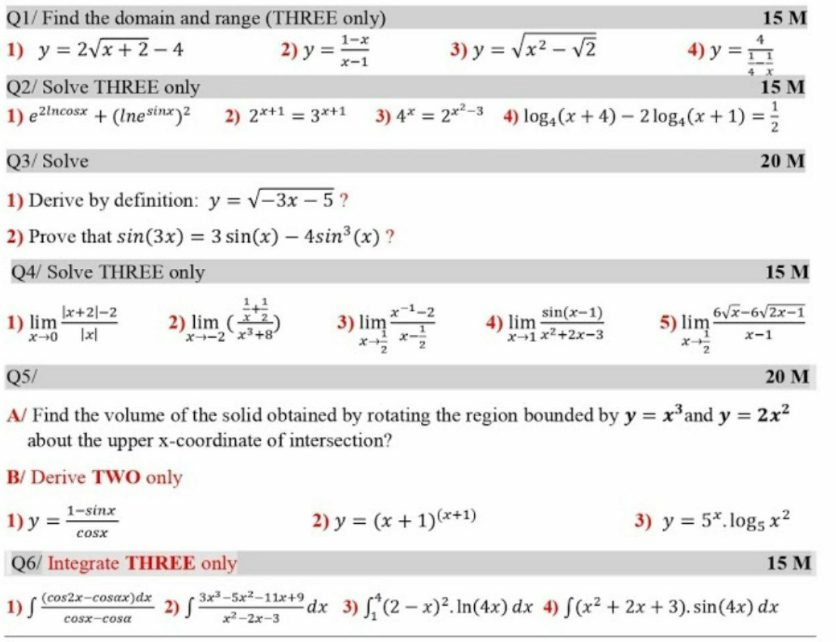Question Number 106604 by mohammad17 last updated on 06/Aug/20

Commented by bemath last updated on 06/Aug/20

$$\mathrm{Q4}\left(\mathrm{5}\right)\:\underset{{x}\rightarrow\mathrm{1}/\mathrm{2}} {\mathrm{lim}}\:\frac{\mathrm{6}\sqrt{\mathrm{x}}−\mathrm{6}\sqrt{\mathrm{2x}−\mathrm{1}}}{\mathrm{x}−\mathrm{1}}\:=\:\frac{\frac{\mathrm{6}}{\:\sqrt{\mathrm{2}}}−\mathrm{0}}{−\frac{\mathrm{1}}{\mathrm{2}}} \\ $$$$=\:−\frac{\mathrm{12}}{\:\sqrt{\mathrm{2}}}\:=\:−\mathrm{6}\sqrt{\mathrm{2}}\:\:\:\:\:@\mathrm{bemath}@ \\ $$
Answered by Dwaipayan Shikari last updated on 06/Aug/20

$${y}=\mathrm{2}\sqrt{{x}+\mathrm{2}}−\mathrm{4} \\ $$$$\left({x}+\mathrm{2}\right)\geqslant\mathrm{0} \\ $$$${Domain}\:{x}\in\left[−\mathrm{2},\infty\right)\: \\ $$$$\frac{{y}+\mathrm{4}}{\mathrm{2}}=\sqrt{{x}+\mathrm{2}} \\ $$$${x}=\frac{\left({y}+\mathrm{4}\right)^{\mathrm{2}} }{\mathrm{4}}−\mathrm{2} \\ $$$$−\mathrm{2}\leqslant{x}<\infty \\ $$$$−\mathrm{2}\leqslant\frac{\left({y}+\mathrm{4}\right)^{\mathrm{2}} −\mathrm{8}}{\mathrm{4}}<\infty \\ $$$$−\mathrm{8}\leqslant\left({y}+\mathrm{4}\right)^{\mathrm{2}} −\mathrm{8}<\infty \\ $$$$\mathrm{0}\leqslant\left({y}+\mathrm{4}\right)^{\mathrm{2}} <\infty \\ $$$$−\mathrm{4}\leqslant{y}<\infty \\ $$$$ \\ $$
Answered by Dwaipayan Shikari last updated on 06/Aug/20

$$\left.\mathrm{4}\right)\underset{{x}\rightarrow\mathrm{1}} {\mathrm{lim}}\frac{{sin}\left({x}−\mathrm{1}\right)}{\left({x}−\mathrm{1}\right)\left({x}+\mathrm{3}\right)}=\underset{{x}\rightarrow\mathrm{1}} {\mathrm{lim}}\frac{\left({x}−\mathrm{1}\right)}{\left({x}−\mathrm{1}\right)\left({x}+\mathrm{3}\right)}=\frac{\mathrm{1}}{\mathrm{4}} \\ $$
Answered by Dwaipayan Shikari last updated on 06/Aug/20

$$\left.\mathrm{4}\right)\int\left({x}^{\mathrm{2}} +\mathrm{2}{x}+\mathrm{3}\right){sin}\mathrm{4}{xdx}= \\ $$$$\int{x}^{\mathrm{2}} {sin}\mathrm{4}{x}+\mathrm{2}\int{xsin}\mathrm{4}{x}+\mathrm{3}\int{sin}\mathrm{4}{x} \\ $$$$=−\frac{\mathrm{1}}{\mathrm{4}}{x}^{\mathrm{2}} {cos}\mathrm{4}{x}+\frac{\mathrm{1}}{\mathrm{2}}\int{xcos}\mathrm{4}{x}−\frac{\mathrm{1}}{\mathrm{2}}{xcos}\mathrm{4}{x}+\frac{\mathrm{1}}{\mathrm{2}}\int{cos}\mathrm{4}{x}−\frac{\mathrm{3}}{\mathrm{4}}{sin}\mathrm{4}{x} \\ $$$$=−\frac{\mathrm{1}}{\mathrm{4}}{x}^{\mathrm{2}} {cos}\mathrm{4}{x}+\frac{\mathrm{1}}{\mathrm{8}}{xsin}\mathrm{4}{x}−\frac{\mathrm{1}}{\mathrm{8}}\int{sin}\mathrm{4}{x}+\frac{\mathrm{1}}{\mathrm{2}}{xcos}\mathrm{4}{x}+\frac{\mathrm{1}}{\mathrm{8}}{sin}\mathrm{4}{x}−\frac{\mathrm{3}}{\mathrm{4}}{sin}\mathrm{4}{x} \\ $$$$=−\frac{\mathrm{1}}{\mathrm{4}}{x}^{\mathrm{2}} {cos}\mathrm{4}{x}+{sin}\mathrm{4}{x}\left(\frac{{x}}{\mathrm{8}}−\frac{\mathrm{5}}{\mathrm{8}}\right)+\frac{\mathrm{1}}{\mathrm{32}}{cos}\mathrm{4}{x}+\frac{\mathrm{1}}{\mathrm{2}}{cos}\mathrm{4}{x}+{C} \\ $$$$ \\ $$
Answered by bemath last updated on 06/Aug/20

$$\mathrm{Q4}\left(\mathrm{1}\right)\:\underset{{x}\rightarrow\mathrm{0}^{+} } {\mathrm{lim}}\:\frac{\mid\mathrm{x}+\mathrm{2}\mid−\mathrm{2}}{\mid\mathrm{x}\mid}=\underset{{x}\rightarrow\mathrm{0}^{+} } {\mathrm{lim}}\frac{\mathrm{x}+\mathrm{2}−\mathrm{2}}{\mathrm{x}}=\mathrm{1} \\ $$$$\underset{{x}\rightarrow\mathrm{0}^{−} } {\mathrm{lim}}\:\frac{\mid\mathrm{x}+\mathrm{2}\mid−\mathrm{2}}{\mid\mathrm{x}\mid}=\:\underset{{x}\rightarrow\mathrm{0}^{−} } {\mathrm{lim}}\:\frac{\mathrm{x}+\mathrm{2}−\mathrm{2}}{−\mathrm{x}}=−\mathrm{1} \\ $$$$\mathrm{since}\:\underset{{x}\rightarrow\mathrm{0}^{+} } {\mathrm{lim}f}\left(\mathrm{x}\right)\:\neq\:\underset{{x}\rightarrow\mathrm{0}^{−} } {\mathrm{lim}f}\left(\mathrm{x}\right)\: \\ $$$$\mathrm{then}\:\underset{{x}\rightarrow\mathrm{0}} {\mathrm{lim}}\:\frac{\mid\mathrm{x}+\mathrm{2}\mid−\mathrm{2}}{\mid\mathrm{x}\mid}\:\mathrm{doesn}'\mathrm{t}\:\mathrm{exist} \\ $$$$@\mathrm{bemath}@ \\ $$
Commented by bemath last updated on 06/Aug/20

Answered by Dwaipayan Shikari last updated on 06/Aug/20

$$\left.\mathrm{3}\right)\underset{{x}\rightarrow\frac{\mathrm{1}}{\mathrm{2}}} {\mathrm{lim}}\frac{\frac{\mathrm{1}}{{x}}−\mathrm{2}}{{x}−\frac{\mathrm{1}}{\mathrm{2}}}=\frac{\mathrm{1}−\mathrm{2}{x}}{\mathrm{2}{x}−\mathrm{1}}.\frac{\mathrm{2}}{{x}}=−\mathrm{1}.\mathrm{4}=−\mathrm{4} \\ $$
Answered by Dwaipayan Shikari last updated on 06/Aug/20

$$\left.\mathrm{2}\right)\underset{{x}\rightarrow−\mathrm{2}} {\mathrm{lim}}\frac{\frac{{x}+\mathrm{2}}{\mathrm{2}{x}}}{{x}^{\mathrm{3}} +\mathrm{8}}=\underset{{x}\rightarrow−\mathrm{2}} {\mathrm{lim}}\frac{\frac{\mathrm{1}}{\mathrm{2}{x}}}{{x}^{\mathrm{2}} −\mathrm{2}{x}+\mathrm{4}}=−\frac{\mathrm{1}}{\mathrm{4}}.\frac{\mathrm{1}}{\mathrm{12}}=−\frac{\mathrm{1}}{\mathrm{48}} \\ $$
Answered by 1549442205PVT last updated on 06/Aug/20

$$\left.\mathrm{Q1a}\right)\mathrm{y}=\mathrm{2}\sqrt{\mathrm{x}+\mathrm{2}}\:−\mathrm{4}\:.\mathrm{y}\:\mathrm{is}\:\mathrm{definited}\:\mathrm{for}\: \\ $$$$\forall\mathrm{x}\in\left[−\mathrm{2};+\infty\right)\Rightarrow\mathrm{D}\left(\mathrm{x}\right)=\left[−\mathrm{2};+\infty\right) \\ $$$$\mathrm{We}\:\mathrm{have}\:\mathrm{y}\geqslant\mathrm{2}.\mathrm{0}−\mathrm{4}=−\mathrm{4}\:\left(\mathrm{since}\:\sqrt{\mathrm{x}+\mathrm{2}}\geqslant\mathrm{0}\right) \\ $$$$\mathrm{Thus},\mathrm{the}\:\mathrm{domain}\:\mathrm{of}\:\mathrm{the}\:\mathrm{values}\:\mathrm{of}\:\mathrm{y}\:\mathrm{be}\: \\ $$$$\mathrm{D}\left(\mathrm{y}\right)=\left[−\mathrm{4};+\infty\right) \\ $$$$\left.\mathrm{Q2a}\right)\mathrm{Solve}\:\mathrm{the}\:\mathrm{equations}: \\ $$$$\mathrm{e}^{\mathrm{2ln}\left(\mathrm{cos}\:\mathrm{x}\right)} =\left(\mathrm{lne}^{\mathrm{sinx}} \right)^{\mathrm{2}} \Leftrightarrow\mathrm{e}^{\mathrm{ln}\left(\mathrm{cosx}\right)^{\mathrm{2}} } +\left(\mathrm{sinx}\right)^{\mathrm{2}} \\ $$$$\Leftrightarrow\mathrm{cos}^{\mathrm{2}} \mathrm{x}=\mathrm{sin}^{\mathrm{2}} \mathrm{x}\left(\mathrm{since}\:\mathrm{e}^{\mathrm{lnN}} =\mathrm{N},\mathrm{lne}^{\mathrm{m}} =\mathrm{m}\right) \\ $$$$\Leftrightarrow\mathrm{cos}^{\mathrm{2}} \mathrm{x}−\mathrm{sin}^{\mathrm{2}} \mathrm{x}=\mathrm{0}\Leftrightarrow\mathrm{cos2x}=\mathrm{0} \\ $$$$\Leftrightarrow\mathrm{2}\boldsymbol{\mathrm{x}}=\frac{\boldsymbol{\pi}}{\mathrm{2}}+\boldsymbol{\mathrm{k}\pi}\Leftrightarrow\boldsymbol{\mathrm{x}}=\frac{\boldsymbol{\pi}}{\mathrm{4}}+\frac{\boldsymbol{\mathrm{k}\pi}}{\mathrm{2}}\: \\ $$$$\left.\mathrm{b}\right)\mathrm{2}^{\mathrm{x}+\mathrm{1}} =\mathrm{3}^{\mathrm{x}+\mathrm{1}} \Leftrightarrow\left(\frac{\mathrm{2}}{\mathrm{3}}\right)^{\mathrm{x}+\mathrm{1}} =\mathrm{1}\Leftrightarrow\mathrm{x}+\mathrm{1}=\mathrm{0} \\ $$$$\Leftrightarrow\boldsymbol{\mathrm{x}}=−\mathrm{1}\: \\ $$$$\left.\mathrm{c}\right)\mathrm{4}^{\mathrm{x}} =\mathrm{2}^{\mathrm{x}^{\mathrm{2}} −\mathrm{3}} \Leftrightarrow\mathrm{2}^{\mathrm{2x}} =\mathrm{2}^{\mathrm{x}^{\mathrm{2}} −\mathrm{3}} \Leftrightarrow\mathrm{x}^{\mathrm{2}} −\mathrm{3}=\mathrm{2x} \\ $$$$\Leftrightarrow\mathrm{x}^{\mathrm{2}} −\mathrm{2x}−\mathrm{3}=\mathrm{0}\:\Delta;'=\mathrm{1}+\mathrm{3}=\mathrm{2}^{\mathrm{2}} \\ $$$$\Rightarrow\mathrm{x}=\mathrm{1}\pm\mathrm{2}\Rightarrow\boldsymbol{\mathrm{x}}\in\left\{−\mathrm{1},\mathrm{3}\right\}\: \\ $$$$\left.\mathrm{d}\right)\mathrm{log}_{\mathrm{4}} \left(\mathrm{x}+\mathrm{1}\right)−\mathrm{2log}_{\mathrm{4}} \left(\mathrm{x}+\mathrm{1}\right)=\frac{\mathrm{1}}{\mathrm{2}}\left(\mathrm{1}\right) \\ $$$$\mathrm{Condition}\:\mathrm{for}\:\mathrm{the}\:\mathrm{eqn}.\mathrm{is}\:\mathrm{deined}\:\mathrm{as}\:\mathrm{x}\geqslant−\mathrm{1} \\ $$$$\left(\mathrm{1}\right)\Leftrightarrow\mathrm{log}_{\mathrm{4}} \left(\mathrm{x}+\mathrm{1}\right)=−\frac{\mathrm{1}}{\mathrm{2}}\Leftrightarrow\mathrm{x}+\mathrm{1}=\mathrm{4}^{−\frac{\mathrm{1}}{\mathrm{2}}} \\ $$$$\Leftrightarrow\mathrm{x}+\mathrm{1}=\frac{\mathrm{1}}{\:\sqrt{\mathrm{4}}}=\frac{\mathrm{1}}{\mathrm{2}}\Leftrightarrow\boldsymbol{\mathrm{x}}=−\frac{\mathrm{1}}{\mathrm{2}}\: \\ $$$$\left.\mathrm{Q3}.\mathrm{a}\right)\mathrm{y}=\sqrt{−\mathrm{3x}−\mathrm{5}}\Rightarrow\mathrm{y}'=\frac{−\mathrm{3}}{\mathrm{2}\sqrt{−\mathrm{3x}−\mathrm{5}}} \\ $$$$\left.\mathrm{b}\right)\mathrm{sin3x}=\mathrm{sin}\left(\mathrm{x}+\mathrm{2x}\right)=\mathrm{sinxcos2x}+\mathrm{cosxsin2x} \\ $$$$=\mathrm{sinx}\left(\mathrm{1}−\mathrm{2sin}^{\mathrm{2}} \mathrm{x}\right)+\mathrm{cosx}.\mathrm{2sinxcosx} \\ $$$$=\mathrm{sinx}−\mathrm{2sin}^{\mathrm{3}} \mathrm{x}+\mathrm{2sinx}\left(\mathrm{1}−\mathrm{sin}^{\mathrm{2}} \mathrm{x}\right) \\ $$$$=\mathrm{3sinx}−\mathrm{4sin}^{\mathrm{3}} \mathrm{x}\:\left(\mathrm{q}.\mathrm{e}.\mathrm{d}\right) \\ $$$$\left.\mathrm{Q4}.\mathrm{a}\right)\underset{\mathrm{x}\rightarrow\mathrm{0}} {\mathrm{Lim}}\frac{\mid\mathrm{x}+\mathrm{2}\mid−\mathrm{2}}{\mid\mathrm{x}\mid}=\underset{\mathrm{x}\rightarrow\mathrm{0}} {\mathrm{lim}}\frac{\mathrm{x}+\mathrm{2}−\mathrm{2}}{\mid\mathrm{x}\mid} \\ $$$$=\underset{\mathrm{x}\rightarrow\mathrm{0}} {\mathrm{lim}}\frac{\mathrm{x}}{\mid\mathrm{x}\mid}=\begin{cases}{\underset{\mathrm{x}\rightarrow−\mathrm{0}} {\mathrm{lim}}\frac{\mathrm{x}}{−\mathrm{x}}=−\mathrm{1}}\\{\underset{\mathrm{x}\rightarrow+\mathrm{0}} {\mathrm{lim}}\frac{\mathrm{x}}{\mathrm{x}}=\mathrm{1}}\end{cases} \\ $$$$\mathrm{Since}\:\mathrm{left}−\mathrm{limit}\neq\mathrm{right}−\mathrm{limit} \\ $$$$\mathrm{the}\:\mathrm{given}\:\mathrm{limit}\:\mathrm{don}'\mathrm{t}\:\mathrm{exist}\: \\ $$$$\left.\mathrm{b}\right)\underset{\mathrm{x}\rightarrow−\mathrm{2}} {\mathrm{lim}}\frac{\frac{\mathrm{1}}{\mathrm{x}}+\frac{\mathrm{1}}{\mathrm{2}}}{\mathrm{x}^{\mathrm{3}} +\mathrm{8}}\underset{\mathrm{x}\rightarrow−\mathrm{2}} {=\mathrm{lim}}\frac{\frac{\mathrm{x}+\mathrm{2}}{\mathrm{2x}}}{\left(\mathrm{x}+\mathrm{2}\right)\left(\mathrm{x}^{\mathrm{2}} −\mathrm{x}+\mathrm{4}\right)}= \\ $$$$=\underset{\mathrm{x}\rightarrow−\mathrm{2}} {\mathrm{lim}}\:\frac{\mathrm{1}}{\mathrm{2x}\left(\mathrm{x}^{\mathrm{2}} −\mathrm{x}+\mathrm{4}\right)}=\frac{\mathrm{1}}{−\mathrm{4}\left(\mathrm{4}+\mathrm{2}+\mathrm{4}\right)}=\frac{−\mathrm{1}}{\mathrm{40}} \\ $$$$\left.\mathrm{c}\right)\underset{\mathrm{x}\rightarrow\frac{\mathrm{1}}{\mathrm{2}}} {\mathrm{lim}}\frac{\mathrm{x}^{−\mathrm{1}} −\mathrm{2}}{\mathrm{x}−\frac{\mathrm{1}}{\mathrm{2}}}=\underset{\mathrm{x}\rightarrow\frac{\mathrm{1}}{\mathrm{2}}} {\mathrm{lim}}\frac{\frac{\mathrm{1}}{\mathrm{x}}−\mathrm{2}}{\frac{\mathrm{2x}−\mathrm{1}}{\mathrm{2}}}=\underset{\mathrm{x}\rightarrow\frac{\mathrm{1}}{\mathrm{2}}} {\mathrm{lim}}\frac{\frac{\mathrm{1}−\mathrm{2x}}{\mathrm{x}}}{\frac{\mathrm{2x}−\mathrm{1}}{\mathrm{2}}} \\ $$$$=\underset{\mathrm{x}\rightarrow\frac{\mathrm{1}}{\mathrm{2}}} {\mathrm{lim}}\frac{−\mathrm{2}}{\mathrm{x}}=−\mathrm{4} \\ $$$$\left.\mathrm{d}\right)\underset{\mathrm{x}\rightarrow\mathrm{1}} {\mathrm{li}\:\mathrm{m}}\frac{\mathrm{sin}\left(\mathrm{x}−\mathrm{1}\right)}{\mathrm{x}^{\mathrm{2}} +\mathrm{2x}−\mathrm{3}}\:\underset{\mathrm{x}−\mathrm{1}=\mathrm{t}} {\:\:=\:}\:\:\underset{\mathrm{x}\rightarrow\mathrm{1}} {\mathrm{lim}}\frac{\mathrm{sin}\left(\mathrm{x}−\mathrm{1}\right)}{\left(\mathrm{x}−\mathrm{1}\right)\left(\mathrm{x}+\mathrm{3}\right)} \\ $$$$=\underset{\mathrm{t}\rightarrow\mathrm{0}} {\mathrm{lim}}\frac{\mathrm{sint}}{\mathrm{t}\left(\mathrm{t}+\mathrm{4}\right)} \\ $$$$=\underset{\mathrm{t}\rightarrow\mathrm{0}} {\mathrm{lim}}\frac{\mathrm{sint}}{\mathrm{t}}×\frac{\mathrm{1}}{\mathrm{t}+\mathrm{4}}=\mathrm{1}×\frac{\mathrm{1}}{\mathrm{4}}=\frac{\mathrm{1}}{\mathrm{4}} \\ $$$$\left.\mathrm{e}\right)\underset{\mathrm{x}\rightarrow\frac{\mathrm{1}}{\mathrm{2}}} {\mathrm{lim}}\frac{\mathrm{6}\sqrt{\mathrm{x}}−\mathrm{6}\sqrt{\mathrm{2x}−\mathrm{1}}}{\mathrm{x}−\mathrm{1}}=\underset{\mathrm{x}\rightarrow\frac{\mathrm{1}}{\mathrm{2}}} {\mathrm{lim}}\frac{\mathrm{6}\left[\mathrm{x}−\left(\mathrm{2x}−\mathrm{1}\right)\right.}{\left(\mathrm{x}−\mathrm{1}\right)\left(\sqrt{\mathrm{x}}+\sqrt{\mathrm{2x}−\mathrm{1}}\right)} \\ $$$$=\underset{\mathrm{x}\rightarrow\frac{\mathrm{1}}{\mathrm{2}}} {\mathrm{lim}}\frac{−\mathrm{6}\left(\mathrm{x}−\mathrm{1}\right)}{\left(\mathrm{x}−\mathrm{1}\right)\left(\sqrt{\mathrm{x}}+\sqrt{\mathrm{2x}−\mathrm{1}}\right)}=\underset{\mathrm{x}\rightarrow\frac{\mathrm{1}}{\mathrm{2}}} {\mathrm{lim}}\frac{−\mathrm{6}}{\:\sqrt{\mathrm{x}}+\sqrt{\mathrm{2x}−\mathrm{1}}} \\ $$$$=\frac{−\mathrm{6}}{\:\sqrt{\frac{\mathrm{1}}{\mathrm{2}}}}=−\mathrm{6}\sqrt{\mathrm{2}} \\ $$
